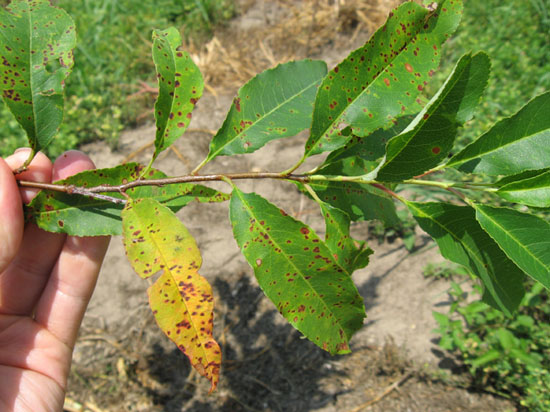Issue 12, July 16, 2010
Cherry Leaf Spot
A current problem on edible and ornamental cherries in Illinois is cherry leaf spot, caused by the fungus, Blumeriella jaapii. I know the pathogen as one of its synonyms, Coccomyces hiemalis. Regardless of what name you use, the disease begins as small reddish/purple spots on the upper leaf surface. These spots turn brown and may merge together. The leaves often turn yellow. The spots themselves may drop out, giving the leaves a shot-hole appearance. The first image, courtesy of diagnostician Travis Cleveland, shows the disease in the field on some ornamental cherry trees. Early defoliation from this disease is common and greatly weakens the tree, predisposing it to winter injury.

The fungal pathogen is produced in an acervulus on the lower leaf surface. An acervulus is an open fruiting body, exposing spores to splashing rain and wind which may move spores to new infection sites. The second image (also courtesy of Mr. Cleveland) shows a mass of spores (conidia) on the leaf surface. We usually see this disease in early to mid-summer. Unlike many disease scenarios, leaves are resistant to infection while in the bud stage. They become susceptible once leaves unfold.

Cherry leaf spot of ornamental trees can be controlled with fungicides, including chlorothalonil with or without thiophanate-methyl, mancozeb with or without copper, myclobutanil, or propiconazole. Applications begin at petal fall and are repeated at 7 to 10 day intervals depending on the fungicide used. Since the fungus survives the winter on fallen leaves, raking and removing leaves in the autumn may help reduce infection the following year. For more on this disease, consult University of Illinois report on plant disease 800, Cherry Leaf Spot. Chemical recommendations are listed in the 2010 Illinois Commercial Landscape and Turfgrass Pest Management Handbook and the Illinois Home, Yard, and Garden Pest Guide.--Nancy Pataky
Author:
Nancy Pataky